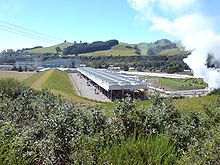Renewable electricity in New Zealand

Renewable electricity in New Zealand is primarily from hydropower. In 2010, 74% of the electricity generated in New Zealand came from renewable sources, a ratio that has been falling for decades while load growth has been met primarily by natural gas-fired power stations. In September 2007, former Prime Minister Helen Clark announced a national target of 90 percent renewable electricity by 2025, with wind energy to make up much of that increase.[1]
The resource consent process has favoured non-renewable energy projects. This century, thermal projects have received consents (Rodney, Stratford) while renewable energy projects have had consent applications declined (Awhitu, Mokau hydro, Mount Cass, Project Hayes, Te Waka, Waitahora).
Sources
Hydroelectricity
Geothermal power
Geothermal power is a small but significant part of the electrical energy generation capacity of the country, providing approximately 13% of the country's electricity with installed capacity of 627 MW.[2] New Zealand, like only a small number of other countries worldwide, has numerous geothermal sites that could be developed for exploitation, and also boasts some of the earliest large-scale use of geothermal energy in the world.
Wind power
As of December 2010, New Zealand had an installed wind generation capacity of 539 MW.[2] Wind power now provides enough electricity to meet the needs of 160,000 New Zealand households, or approximately 3% of the country's electricity demand.[3] Wind farms with a further capacity of 80 MW are under construction,[4] with approval granted or being sought for another 2,875 MW.[5]
Ocean power
New Zealand has large ocean energy resources but does not yet generate any power from them. TVNZ reported in 2007 that over 20 wave and tidal power projects are currently under development.[6] However, not a lot of public information is available about these projects. The Aotearoa Wave and Tidal Energy Association was established in 2006 to "promote the uptake of marine energy in New Zealand". According to their latest newsletter,[7] they have 59 members. However the association doesn't list these members or provide any details of projects.[8]
From 2008 to 2011, the government Energy Efficiency and Conservation Authority is allocating $2 million each year from a Marine Energy Deployment Fund, set up to encourage the utilisation of this resource.[9]
The greater Cook Strait and Kaipara Harbour seem to offer the most promising sites for using underwater turbines. Two resource consents have been granted for pilot projects in Cook Strait itself and in the Tory Channel, and consent has been granted for up to 200 tidal turbines at the Kaipara Tidal Power Station. Other potential locations include the Manukau and Hokianga Harbours, and French Pass. The harbours produce currents up to 6 knots with tidal flows up to 100,000 cubic metres a second. These tidal volumes are 12 times greater than the flows in the largest New Zealand rivers.
Annual electricity generation
| Year | Hydro | Thermal | Geothermal | Wind | Total | % Renewable |
|---|---|---|---|---|---|---|
| 1975 | 16,497 | 1,931 | 1,350 | - | 20,126 | 90% |
| 1980 | 19,171 | 1,959 | 1,206 | - | 22,700 | 91% |
| 1985 | 19,511 | 6,555 | 1,165 | - | 27,673 | 76% |
| 1990 | 22,953 | 5,956 | 2,091 | - | 31,467 | 81% |
| 1995 | 27,259 | 5,426 | 2,049 | 1 | 35,244 | 85% |
| 2000 | 24,387 | 10,474 | 2,756 | 119 | 38,285 | 73% |
| 2005 | 23,094 | 14,286 | 2,981 | 608 | 41,514 | 66% |
| 2010 | 24,470 | 11,140 | 5,551 | 1,618 | 43,401 | 74% |
| 2014 | 24,094 | 9,087 | 6,847 | 2,188 | 42.230 | 80%[10] |
A glance at these figures shows that for the stated target to be attained, current thermal generation will have to be decommissioned and not replaced. Even if the annual total consumption doubles from the 2005 figure ( as it did from 1975 to 2005 ), with all additional generation met by non-thermal means, a static thermal generation of 14,305 on a total of 83,340 is still 17 percent. The most likely candidate for decommissioning would be the 1000 MW Huntly power station, a coal and gas power station that was commissioned in 1983.
While there are some non-technical barriers to the widespread use of renewables, global warming concerns coupled with high oil prices and increasing government support are driving increasing growth in the renewable energy industries.[11]
To boost the "renewables" ratio, geothermal power is often counted as renewable, even though the geothermal heat reservoirs are depleted (observably so at Wairakei, the longest-running[citation needed]), and, they are not emissions-free. For example, the Ngawha geothermal field emits an unusually high amount of CO2 (350 tonnes CO2 per GWh [12]) and the geothermal fields plus natural hot springs draining to the Waikato river deliver sufficient arsenic to render the water unsafe to drink without special treatment[citation needed]. Re-injection of the waste geothermal fluid can reduce these problems (even extending the life of the field), but involves additional expense.
See also
References
- ^ Clark, Helen (2007-09-20). "Launch of emissions trading scheme". New Zealand Government. Retrieved 2010-01-19.
- ^ a b c "Energy Data File". MED. July 2011.
- ^ "Wind generation in New Zealand". New Zealand Wind Energy Association. Retrieved 2010-02-12.
- ^ "Wind energy basics" (PDF). New Zealand Wind Energy Association. Retrieved 2010-02-12.
- ^ "Proposed wind farms". New Zealand Wind Energy Association. Retrieved 2010-02-12.
- ^ "Tidal power rides wave of popularity". TVNZ. 2 December 2007.
- ^ "AWATEA newsletter" (PDF). 10 February 2008.
- ^ "Aotearoa Wave and Tidal Energy Association".
- ^ "Marine Energy". Energy Efficiency and Conservation Authority.
- ^ "Ministry of Business, Innovation & Employment, Annual electricity generation and consumption".
- ^ "New Zealand Energy Strategy to 2050: Towards a sustainable low emissions energy system" (PDF). MED.
- ^ "Geothermal". Energyinfo.
